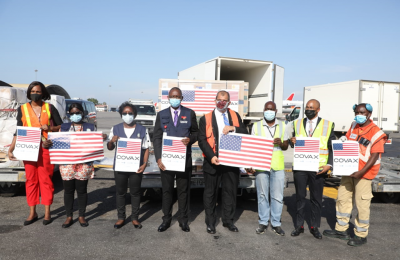
When COVID-19 vaccines landed in countries across the globe in early 2021, the vaccine supply chain was tested significantly, facing a familiar problem: storage of vaccines at very low temperatures. Most COVID vaccines are required to be kept cold and some require ultra-cold temperatures—as low as -80 degrees Celsius as they are transported to vaccination sites through challenging conditions.
The term "cold chain" refers to a temperature-controlled supply chain comprising refrigerated production, storage, and distribution facilities supported by equipment that can constantly maintain the required low-temperature range. This cold chain is required to preserve the integrity and quality of the vaccines until delivery to the end users.
In Angola, the USAID Global Health Supply Chain Program-Procurement and Supply Management (GHSC-PSM) project provides technical assistance to the Ministry of Health (MOH), Agency for Medicines and Medical Supplies Central Medical Store (CECOMA), and other in-country implementing partners to store COVID-19 vaccines in cold or ultra-cold chains until delivery to the last mile. This effort seeks to build on past and current investments to strengthen, integrate, and optimize vaccine supply chain systems across all levels of the country’s supply chain to help achieve its COVID-19 vaccination targets and deliver safe and effective COVID-19 vaccines.
“The reach of population immunization depends, at all levels, on everyone’s participation and dedication, “said Emerald Norman, COVAX Senior Technical Advisor for GHSC-PSM in Angola.
Specifically, GHSC-PSM is working to improve health authorities’ ability to successfully store and distribute all approved vaccines. The project has supported the installation and programming of ultra-cold chain (UCC) freezers across eight provinces. Their role includes leading COVID-19 vaccine distribution, mobilizing both government fleets and private-sector, third-party logistics (3PL) providers to distribute from all levels to the last mile and in a manner that guarantees the safety and efficacy of the vaccines to meet immunization demands. “The international challenge is to provide vaccines that are safe, of good quality, and in good condition,” said Dr. Alda de Sousa, coordinator of Angola’s National Vaccination Program.
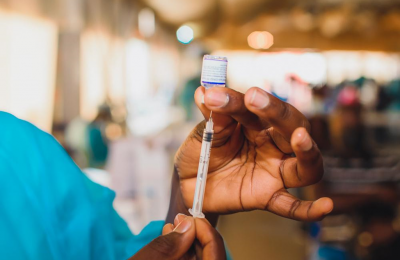
A cold vaccine’s journey through Angola
The work began with the MOH procuring vaccines and receiving donations from partners such as the United States Government, through COVAX. GHSC-PSM worked together with UNICEF and WHO to conduct arrival quality inspections and validations to confirm that the procured and donated vaccines namely: Pfizer, Oxford-AstraZeneca, Pfizer-BioNTech, and Sinopharm—meet international and country-level quality specifications before being received into central storage at the Central Vaccine Deposit. In the case of the Pfizer vaccine, besides the standard process, temperature monitors are checked to confirm if vaccines have had any exposure to heat. Once verified that they are within the standard temperature, they are stored in ultra-cold equipment, and a report is sent to the manufacturer for approval of vaccine consumption.
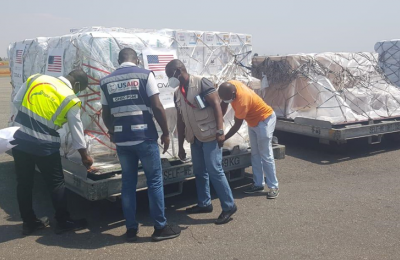
The vaccines are distributed according to the plan developed by the MOH and its partners. Then, vaccines are moved along the cold chain from the central level to the provinces and from the provincial level to the municipalities, adhering closely to standard processes of cold chain distribution to ensure the safety and efficacy of the vaccines are retained.
Proper storage, handling, and distribution of COVID-19 vaccines require a number of warehousing tools and equipment: specialized ultra-cold freezers; refrigerated chambers for defrosting, mini solar and electric freezers for portable storage; and isothermal boxes, accumulators, and other cooling agents for the goods in transit to the final destination.
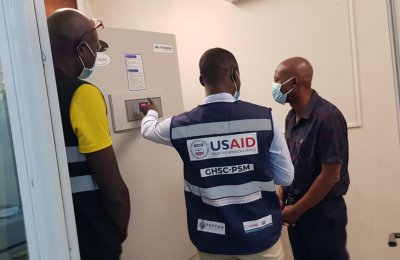
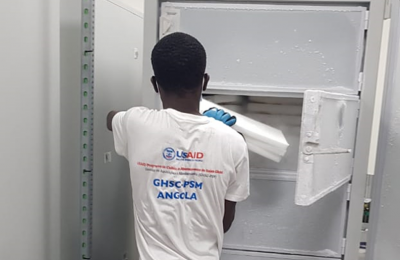
The use and maintenance of vaccine storage equipment requires qualified personnel. For this purpose, GHSC-PSM works with experienced logisticians from the Central Vaccine Deposit to share technical knowledge related to the transport and storage of vaccines. The MOH further hired trained technicians to maintain the cold chain equipment.
Building sustainable solutions
The Government of Angola trusted USAID GHSC-PSM’s support because of their technical expertise and their experience with the cold chain.
GHSC-PSM began by conducting a review of local private and public cold chain capacity before the vaccine's arrival. The country had already done a pre-assessment to confirm there was adequate capacity for a stable energy supply at the various vaccine centers, with solar panels, back-up generators, and electricity. GHSC-PSM helped the MOH to install donated UCC equipment in provinces.
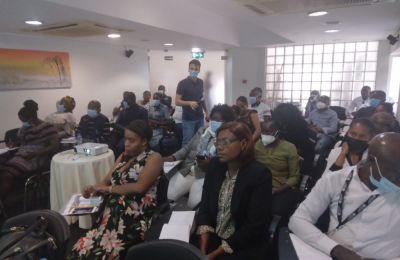
However, installation required training of a cohort of logisticians and supervisors. While UNICEF provided training at the central level, GHSC-PSM focused logistics training at the provincial level where the new equipment was installed. Trained personnel needed to ensure the physical integrity and operation of the equipment would be stable and sustainable.
GHSC-PSM, through a thorough and competitive procurement process, secured a 3PL provider to distribute vaccines to the last mile, complementing the government fleet, to ensure vaccines are distributed to the hardest-to-reach areas of the country to meet immunization coverage targets of the country.
Funding was received in March 2022 and implementation of UCC activities started in May 2022, with the goal to distribute vaccines from central stores to 14 provinces. By July, almost 2.8 million vaccine doses had reached 94% of Angola’s provinces. This remarkable achievement was the result of careful planning and diligent work of an entire team of supply chain staff, healthcare workers, and implementing partners.
It became clear throughout the process that monitoring the flow of information and effective communication between the different levels of the distribution chain are of paramount importance for delivering and receiving vaccines. Teamwork, appreciation, and involvement of technicians all along the way delivered a major advantage.
The team also learned that intensifying supervision in the field of vaccine logistics is essential for effective management of the distribution chain.
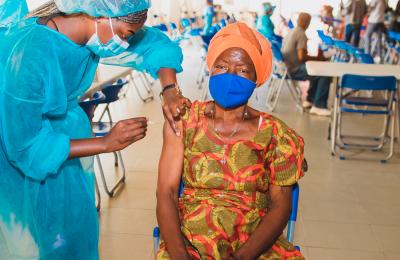
Finally, after vaccines pass through the entire supply chain, they arrive at vaccination posts. All vaccination posts are equipped with equipment, supervisors and trained logistics experts to ensure the conservation of vaccines. Daily, in addition to stock control, records are made to ensure that vaccines are within the deadlines and temperature ranges recommended by the manufacturer to get the now safe and effective vaccine into arms to protect people.
ABOUT THIS STORY
USAID’s Global Health Supply Chain Program – Procurement and Supply Management (GHSC-PSM) has operations in 30 countries worldwide, including Angola. This program works to reduce costs and increase efficiencies in global and national supply chains. Its overriding purpose is to ensure the uninterrupted supplies of health commodities. It supports the U.S. President’s Emergency Plan for AIDS Relief (PEPFAR), the President’s Malaria Initiative (PMI), and USAID’s newborn child, maternal health, and population and reproductive health program.
In Angola, PSM employs cutting-edge technologies and commercial best practices to increase the efficiency of health supply chains. It provides technical assistance to government ministries involved in public administration, financial management and other areas that play a role in strengthening health systems. Technical assistance to the Government of the Republic of Angola (GRA) focuses primarily on support to the Ministry of Health (MOH) and the Central Procurement Agency for Medicines and Medical Supplies Central Medical Store (CECOMA).
